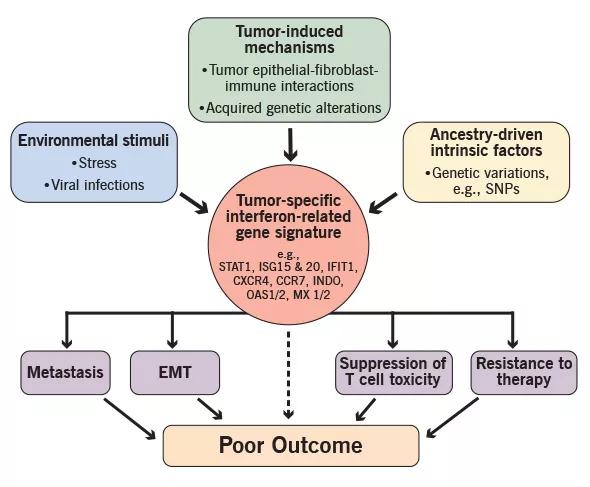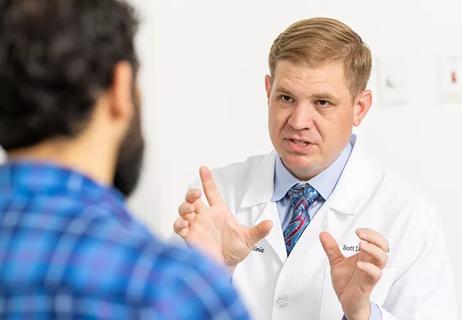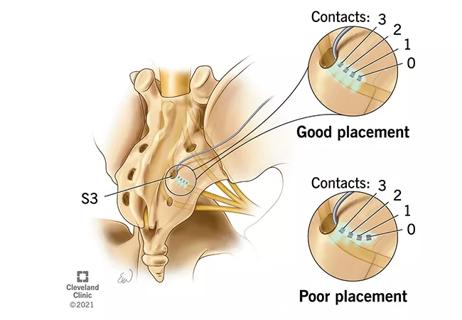Recipient of a Prostate Cancer Foundation Special Challenge Award

Cleveland Clinic is a non-profit academic medical center. Advertising on our site helps support our mission. We do not endorse non-Cleveland Clinic products or services. Policy
Production of endogenous interferons is triggered by exposure to viruses, bacteria and other infectious agents. They are the innate immune system’s major initial response to an invading pathogen. The antiproliferative, apoptotic and antiangiogenic effects of interferons, and their ability to modulate immune responses, have led to the administration of exogenous interferons as an adjunct therapy for some cancers.
Conversely, the increased expression of a subset of interferon-induced proteins in several different tumors correlates strongly with the tumors’ ability to resist radiation and chemotherapy. In effect, the elevated expression of approximately 25 interferon-induced proteins— a response known as the interferon-related DNA damage resistance signature (IRDS) —appears to inhibit treatment of the cancer and predispose to a worse outcome.
Why this happens, and why the detrimental IRDS response is much more likely to occur in African-American men with prostate cancer than in their white counterparts, is the subject of a new collaborative research project involving Cleveland Clinic, the National Cancer Institute, the University of Chicago and Philadelphia’s Thomas Jefferson University. The effort is funded by a $600,000 Special Challenge Award from the Prostate Cancer Foundation.
The IRDS collaboration resulted from the intersection of independent and seemingly unrelated studies at the member institutions. These studies involved how cells respond to interferon, the analyses of proteins expressed in radiation-resistant breast cancers, and the dramatic ethnic differences in the aggressiveness of prostate cancers. The prevalence of the IRDS genetic signal is 50 percent in African-American prostate cancer patients, compared with 20 percent in European-American patients, which may help explain the observed ethnic differences in mortality.
Cells respond to interferons by inducing the expression of hundreds of proteins. But the laboratory of Ralph R. Weichselbaum, MD, at the University of Chicago showed that only a small subset of these proteins was constitutively expressed at a high frequency in several different cancers and, importantly, that IRDS expression correlated strongly with increased resistance to ionizing radiation and DNA-damaging chemotherapy.
Our laboratory discovered that expression of the same subset of genes was sustained in cells in tissue culture that were treated with a low concentration of interferon for many days. The mechanism depended upon the formation of a novel variant of ISGF3, the major transcription factor responsible for transmitting signals from the interferon receptor on the cell surface to genes in the nucleus. Our working hypothesis is that low steady-state levels of endogenous interferon in the tumor microenvironment are responsible for the IRDS signature.
The laboratory of Stefan Ambs, PhD, MPH, at the National Cancer Institute demonstrated the striking ethnic difference in the prevalence of the IRDS in prostate tumors of African-Americans. It also showed that these patients experience an excess mortality that is partly explained by an intrinsically aggressive disease.
The first aim of the collaborative research project is to compare the frequency and magnitude of IRDS expression in archival samples of prostate cancers from African-American and European-American patients. This comparison will utilize samples from a database established by Cleveland Clinic Glickman Urological & Kidney Institute Chairman Eric A. Klein, MD. We also will investigate the correlation between IRDS expression and clinical outcomes.
The project’s second goal is to determine the prevalence and consequence of IRDS in disease progression, a study that will be conducted by Karen Knudsen, PhD, of Thomas Jefferson University. Included will be an analysis of the impact of androgen receptor signaling and hormone therapy on IRDS expression and outcome.
In the project’s third initiative, our laboratory and the Weichselbaum laboratory will investigate whether transient inhibition of the interferon response in prostate tumors will sensitize them to radiation or chemotherapy. Several inhibitors of the JAKSTAT pathway, which is essential for the ability of cells to respond to interferons, already are in clinical use in other diseases. An attractive possibility is that pretreatment with such an inhibitor will downregulate the tumor’s response to endogenous interferon and thus downregulate the expression of IRDS genes, sensitizing the tumors to DNA damage inflicted by radiation or chemotherapy.
It will be of major benefit to patients if reducing the amount of radiation or chemotherapy needed to achieve a given clinical effect is possible.
Dr. Stark (starkg@ccf.org) is the Distinguished Scientist of Cleveland Clinic and works in the Lerner Research Institute’s Department of Molecular Genetics. He and Glickman Urological & Kidney Institute Chairman Eric A. Klein, MD, are principal investigators on the IRDS research project.

Figure 1. Potential origin and effects of the interferon-related gene signature (IRDS) in tumor biology. Tumor-induced mechanisms, environmental stimuli or ancestry-driven intrinsic factors may induce the IRDS in prostate tumors. This signature may lead to poor outcomes by mechanisms that include the epithelial to mesenchymal transition (EMT) and consequent increased metastatic potential, suppression of T cell toxicity and resistance to therapy. This figure and legend are from Wallace TA, Martin DN, Ambs, S. Interactions among genes, tumor biology and the environment in cancer health disparities: examining the evidence on a national and global scale. Carcinogenesis. 2011; Aug; 32(8); 1107-21. Used with permission from Dr. Ambs and Oxford University Press.
Image by Nevit Dilmen, via Wikimedia Commons

Review the advantages and disadvantages of newer interventions

Pioneering and refining the approach in pyeloplasty, nephrectomy and more

Unlike earlier pills, new drugs do not cause liver toxicity

Male factors play a role in about half of all infertility cases, yet men often are not evaluated

Hadley Wood, MD, shares her vision as the new editor-in-chief of Urology

Study leverages data from the ROSETTA trial

More on the procedure and the institutional experience

Explain some, but not all, of lower utilization